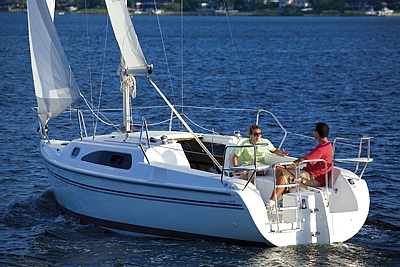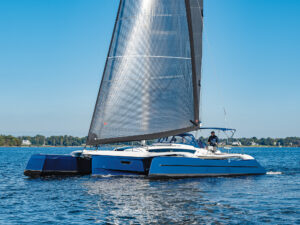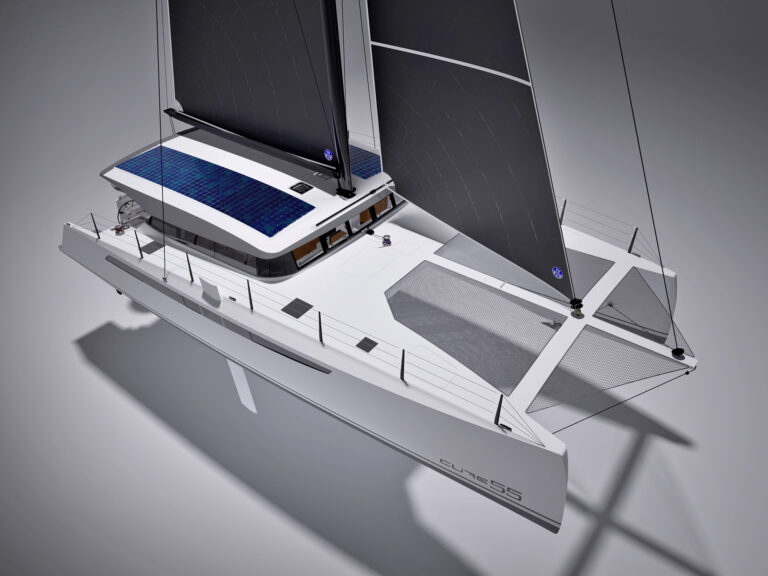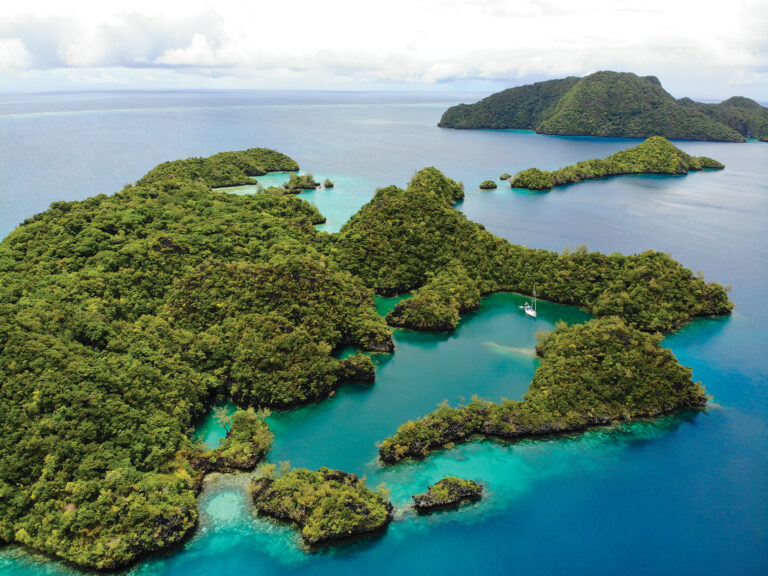
The Catalina 250 is a flooding-water-ballast trailerable boat. There is no fixed
ballast, and for tracking the boat relies on an unweighted centerboard. Righting
moment comes from a flooding system that permits the double bottom of the boat
to be filled with seawater, which is emptied when it comes time to leave the
water and winch the vessel back onto the trailer again. There is no provision
for pumping the water to the high side as is common aboard the BOC boats. There
is no fixed ballast on the bottom of a fixed keel so the boat should never be
sailed without the water ballast in place.
When our Boat Of The Year judging team stepped aboard the 250, we found what we
considered a large cockpit equipped with an outboard rudder and an outboard
motor. The rig is of a masthead configuration with slides and conventional
reefing on the mainsail and roller furling on the jib. The mast is stepped on
deck and supported by wire rigging over single spreaders. There are no runners
or movable stays to contend with. The deck-stepped rig is fairly light, both for
ease of stepping and because the boat does not load the rig aggressively.
It was breezy on our test sail and we reefed the mainsail. There was a minor
inversion in the mast caused by mainsail leech tension in the reefed position.
Sailing performance, either in speed or control, was not particularly refined.
There was continuous strong weather helm that increased in any gusty puffs. In
addition, the boat had a tendency to oversteer when tacking or jibing. And
finally, movement on deck fore and aft was compromised by the boat’s narrow
beam, narrow lifeline base and tender behavior under way.
Going below, the ladder is set up at a good angle, though it could use some
support on each side to keep one’s feet from sliding off when heeled. The
interior is quite versatile for a boat this size, especially when the
companionway pop top is deployed for full standing headroom below. Forward there
is a small V-berth suitable for kids or stowage. Under the mast there is a
circular settee facing aft with a table that converts also to a cockpit table
when mounted in brackets topside. The V-berth can be made large enough for
adults by removing the forward divider of the settee. This still leaves room for
a couple of small kids on the balance of the settee seats. There is an enclosed
head to port with a Porta Potti and a minimum galley to starboard. The icebox is
in fact a removable cooler, making that picnic on the beach all the more
convenient. There is also a huge double berth aft that suffers only from
relatively low headroom. General workmanship is below that of the fixed-keel
Catalina boats.
The waters of the Pacific Ocean are cold and my wife and I do much of our Laser
sailing on inland lakes, often combining day sails with a camping trip. In lieu
of using a travel trailer on wheels or a slide-in truck camper for a camping
vehicle, I can see how many sailor/campers might choose a Catalina 250. At the
very least, when one tires of the Laser one can sail around the lake in comfort
with family, friends and hors d’oeuvres. And of course a night afloat can
certainly be more enjoyable than a night blocked up on rubber tires or in a
tent. Given the cost of even a non-motorized RV these days, the Catalina 250 is
certainly priced competitively.
The geometry required to make a trailerable flooding ballast boat function is
such that they are a little awkward in appearance. This is accentuated by the
high freeboard and narrow beam required to meet highway trailering limits.
Unfortunately we did not get an opportunity to test the Catalina 250
systematically against other flooding-water-ballast or swing keel trailerable
boats in 1995. Such boats almost always score poorly relative to their fixed
keel counterparts in both sailing performance and power to carry sail.
Apart from issues of portability and low cost, the more conventional fixed-keel
boats manufactured by Catalina are superior to this boat in most respects.
Certainly if one is on a limited budget but wants a refined, good sailing,
capable boat, one should consider a previously owned Catalina fixed-keel vessel.
Indeed the best and most distinctive points of the Catalina 250 include ease of
trailering, a large cockpit and large internal volume. If one’s uses are limited
to protected waters, and ease of trailering with a medium-size vehicle is high
on the agenda, then this boat scores admirably.
Catalina 250 Specifications:
LOA: 25’0″ (7.62 m.)
LWL: 21’3″ (6.48 m.)
Beam: 8’6″ (2.59 m.)
Draft (bd up): 1’8″ (0.51 m.)
Draft (bd dn): 5’9″ (1.75 m.)
Ballast: Water, 1,200 lbs. (544 kgs.)
Disp: (dry) 2,400 lbs. (1,090 kgs.)
Sail area: 271 sq.ft. (25.18 sq.m.)
Mast above water: 33’3″ (10.2 m.)
Fuel tankage: Portable 6 gal. (23 l.)
Water tankage: 5 gal. (19 l.)
Auxiliary: dealer-equipped outboard
Designer: Catalina Yachts design team
Base price: $15,900 (FOB Calif.)
Catalina Yachts Inc.
21200 Victory Blvd.
Woodland Hills, CA 91367
Phone (818) 884-7700








